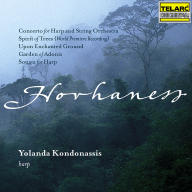Hovhaness began stirring controversy with his music during the 1930s. While many established musicians criticized his compositions, others praised him for his global approach. Although his Symphony No. 1 was denounced by Leonard Bernstein as "filthy ghetto music", Hovhaness was embraced by such musicians as Leopold Stokowski who conducted the American premiere of his 1936 composition, The Exile, inspired by the persecution and exile of Armenians in Turkey, and Andre Kostalanetz recorded his 1975 composition, Rubiyat Of Omar Khayyam.
The son of Armenian and Scottish immigrants, Hovhaness composed his first pieces at the age of four. By the time he reached his teens, he was composing operatic works. As pianist and organist for a local Armenian church, he became known for his skill at improvising on ancient modes. He sharpened his compositional talents through study with Frederick Converse at the New England Conservatory of Music in Boston and Bohuslav Martinu at Tanglewood.
Hovhaness, who was given his professional name by his high school librettist, was extremely prolific. Although he destroyed many of his early compositions in 1940, the works that survived number in the hundreds. Among Hovhaness' best known compositions are Lousadzak (The Coming Of Light), written for piano and strings in 1945, The Prayer Of Saint Gregory, written for trumpet and symphony orchestra in 1952, and, Seventeen Prayers, written for oud, lute or guitar and string quartet or string orchestra in 1975. Hovhaness' composition, Symphony No. 3 has been described as "a tribute to the Mozartian classical sonata form." He died June 21, 2000 at the age of 89. ~ Craig Harris, Rovi


















